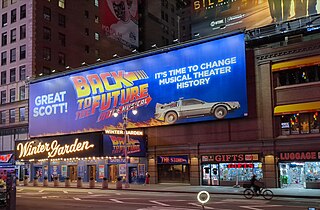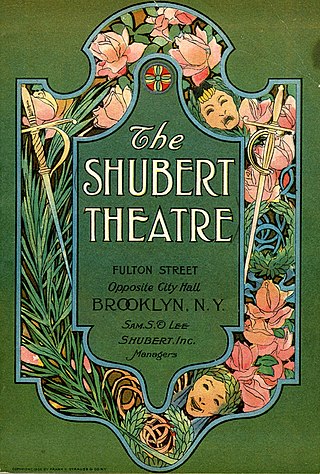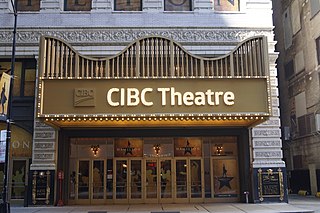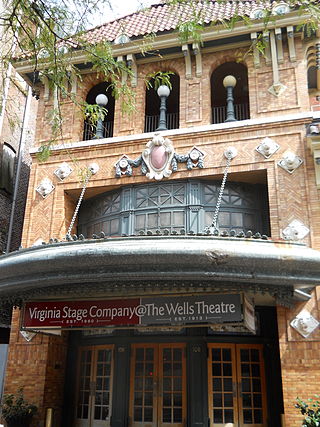Shubert Theatre or Shubert Theater may refer to one of the following theaters in the United States:

The Winter Garden Theatre is a Broadway theatre at 1634 Broadway in the Midtown Manhattan neighborhood of New York City. Originally designed by architect William Albert Swasey, it opened in 1911. The Winter Garden's current design dates to 1922, when it was completely remodeled by Herbert J. Krapp. Due to the size of its auditorium, stage, and backstage facilities, it is favored for large musical productions. It has 1,600 seats and is operated by The Shubert Organization. The auditorium interior is a New York City landmark.

The Shubert Organization is a theatrical producing organization and a major owner of theatres based in Manhattan, New York City. It was founded by the three Shubert brothers — Lee, Sam, and Jacob J. Shubert — in the late 19th century. They steadily expanded, owning many theaters in New York and across the United States. Since then it has gone through changes of ownership, but it is still a major theater chain.

The Palace Theatre is a Broadway theater at 1564 Broadway, at the north end of Times Square, in the Midtown Manhattan neighborhood of New York City. Designed by Milwaukee architects Kirchhoff & Rose, the theater was funded by Martin Beck and opened in 1913. From its opening to about 1929, the Palace was considered among vaudeville performers as the flagship venue of Benjamin Franklin Keith and Edward Franklin Albee II's organization. The theater had 1,648 seats across three levels as of 2018.

CIBC Theatre is a performing arts theater located at 18 West Monroe Street in the Loop area of downtown Chicago. It is operated by Broadway In Chicago, part of the Nederlander Organization. Opened in 1906 as the Majestic Theatre, it currently seats 1,800 and for many years has presented Broadway shows. In its early years, the theater presented vaudeville celebrity acts.

The Cowles Center for Dance and the Performing Arts is a performing arts center and flagship for dance in downtown Minneapolis, Minnesota, United States. The Cowles Center was developed as an incubation project by Artspace Projects, Inc and includes the refurbished 500-seat Goodale Theater ; the Hennepin Center for the Arts, home to 20 leading dance and performing arts organizations; a state-of-the-art education studio housing a distance learning program; and an atrium connecting the buildings. The Cowles Center is a catalyst for the creation, presentation and education of dance in the Twin Cities.

Herbert J. Krapp (1887–1973) was a 20th-century theatre architect and designer, notable for his contributions to Broadway theater district architecture. Known for his innovative approach to design, his built work favors width, rather than depth, to create better sightlines for an "intimate theatre" experience.

The Missouri Theatre, is a concert and entertainment venue in downtown Columbia, Missouri, occupying most of a city block between 9th street between Locust and Elm Streets. It was designed after the Opéra Garnier by the Boller Brothers, built in 1928, and is on the National Register of Historic Places. It is Columbia's only surviving pre-Depression movie palace and vaudeville stage. In 2011, the University of Missouri began a three-year lease of the facility. The Missouri Theatre is the resident home of the Missouri Symphony Orchestra, and is also frequently used by University of Missouri and civic groups. As of July 1, 2014, The University of Missouri took over ownership of the Missouri Theatre. It is one of the main performance venues for the University of Missouri School of Music.

The Bijou Theatre is a theater located in Knoxville, Tennessee, United States. Built in 1909 as an addition to the Lamar House Hotel, the theater has at various times served as performance venue for traditional theatre, vaudeville, a second-run moviehouse, a commencement stage for the city's African-American high school, and a pornographic movie theater. The Lamar House Hotel, in which the theater was constructed, was originally built in 1817, and modified in the 1850s. The building and theater were added to the National Register of Historic Places in 1975.

An atmospheric theatre is a type of movie palace design which was popular in the late 1920s. Atmospheric theatres were designed and decorated to evoke the feeling of a particular time and place for patrons, through the use of projectors, architectural elements and ornamentation that evoked a sense of being outdoors. This was intended to make the patron a more active participant in the setting.

Miller Symphony Hall is a 1,100-seat performing arts facility in Allentown, Pennsylvania that hosts the Allentown Symphony Orchestra. The hall was previously known as Central Market (1896), Lyric Theater (1899), and Allentown Symphony Hall (1959). In 2012, it was renamed for the Miller family, longtime owners of the hall and of The Morning Call newspaper.

The Mainstreet Theater, also commonly referred to as The Empire Theater, is a historic theater in downtown Kansas City, Missouri in the Power & Light District. The theater was landmarked and placed on the National Register of Historic Places in February 2007.

The Wells Theatre is a performing arts venue located in downtown Norfolk, Virginia. It has housed the Virginia Stage Company since 1979. The Wells Theatre is owned and operated by the City of Norfolk and is part of The Seven Venues.

The Orpheum Theatre is a historic theater in downtown Wichita, Kansas, United States. It was designed by renowned theatre architect John Eberson with funding from a group of local investors and opened on September 4, 1922.

The Majestic Theatre is a performing arts theater in the City Center District of Downtown Dallas. It is the last remnant of Theater Row, the city's historic entertainment center on Elm Street, and is a contributing property in the Harwood Street Historic District. The structure is a Dallas Landmark and is listed on the National Register of Historic Places.

The Mississippi Lofts and Adler Theatre is an apartment building and theater complex located in downtown Davenport, Iowa, United States. It is individually listed on the National Register of Historic Places by its original name, the Hotel Mississippi and RKO Orpheum Theater. The Hotel Mississippi was listed on the Davenport Register of Historic Properties in 2005. In 2020 the complex was included as a contributing property in the Davenport Downtown Commercial Historic District.

The Columbia Theatre was an American burlesque theater on Seventh Avenue at the north end of Times Square in Midtown Manhattan, New York City. Operated by the Columbia Amusement Company between 1910 and 1927, it specialized in "clean", family-oriented burlesque, similar to vaudeville. Many stars of the legitimate theater or of films were discovered at the Columbia. With loss of audiences to cinema and stock burlesque, the owners began to offer slightly more risqué material from 1925. The theater was closed in 1927, renovated and reopened in 1930 as a cinema called the Mayfair Theatre. It went through various subsequent changes and was later renamed the DeMille Theatre. Nothing is left of the theater.
Joan Kent Dillon was a teacher, a nationally known historic preservation activist and an author.

The Palace Theatre is a historic theater in Saint Paul, Minnesota. Dating from 1916, it was renovated in 2016 to become a live music venue.

The Historic Jayhawk State Theatre of Kansas, is a theater located in downtown Topeka, Kansas, United States. The theatre opened on August 16, 1926. The Jayhawk Hotel & Crosby Bros shopping complex where attached to the theatre making it a grand complex for visitors to eat, sleep and be entertained.






















